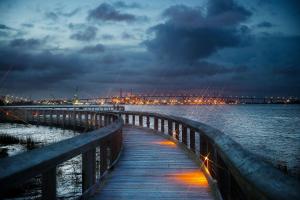 Charleston’s history is one of the most interesting, dynamic, and rich of any city in the United States. The city was named after King Charles II, who granted the Carolina territory to a group of his friends, the Lords Proprietors. In 1670, the city was settled and given the name Charles Towne. Renamed Charleston after the Revolutionary War, the town’s location guaranteed it would become a rich city quickly, and it did. In less than 100 years, it grew from a modest colonial seaport to one of the wealthiest areas in the colonies. The prosperity continued through the middle of the nineteenth century, due to imports, trade, and the growing of cotton and rice. Charleston’s wealth, growth, and location near the ocean meant it was often under attack. Not only was the city assaulted by other countries such as France, but it also battled seafaring pirates and Native Americans. To stifle attack, the city built a fortification wall, and Charleston became known as the Walled City. Two buildings remain from that time: the Powder Magazine, which stored all the city’s gunpowder, and the Pink House, a colonial tavern. During the American Revolution, Charleston was of course a major player. Colonists participated in their own protests against British rule, including seizing tea and storing it in the Exchange and Custom House. In 1774, the Continental Congress was elected in Charleston, and the city was the target of British attacks. In 1780, General Benjamin Lincoln was forced to surrender over 5000 men, and the Siege of Charleston was the greatest American defeat of the Revolution. The British controlled the city until 1782, and the city’s name was officially changed to Charleston the next year. African and Indian slavery was common in Charleston from the beginning, and the people were firmly for states’ rights in the middle of the nineteenth century. On December 20, 1860, South Carolina was the first state to secede from the Union. On January 9, 1861, Charleston’s Citadel cadets fired the first shots of the Civil War on the Union ship Star of the West as it entered Charleston’s harbor. Three months later, in April of 1861, Confederate soldiers fired on Fort Sumter and began the Civil War. Charleston was the site of the first successful submarine warfare in 1864 when the H.L. Hunley attacked the USS Housatonic. Union troops entered the city in 1865 and seized the United States Arsenal and the Citadel Military Academy, turning it into federal garrison. After the war, Charleston was financially devastated, but by reducing its dependence on agriculture, it again became a trade center. As in the rest of the country, during the first few decades of the twentieth century, industry and trade increased dramatically. Later, the military, tourism, and medical facilities ensured Charleston would continue to be a major city in the South. Today, Charleston is revered for its history, its resilience, and its people.
Charleston’s history is one of the most interesting, dynamic, and rich of any city in the United States. The city was named after King Charles II, who granted the Carolina territory to a group of his friends, the Lords Proprietors. In 1670, the city was settled and given the name Charles Towne. Renamed Charleston after the Revolutionary War, the town’s location guaranteed it would become a rich city quickly, and it did. In less than 100 years, it grew from a modest colonial seaport to one of the wealthiest areas in the colonies. The prosperity continued through the middle of the nineteenth century, due to imports, trade, and the growing of cotton and rice. Charleston’s wealth, growth, and location near the ocean meant it was often under attack. Not only was the city assaulted by other countries such as France, but it also battled seafaring pirates and Native Americans. To stifle attack, the city built a fortification wall, and Charleston became known as the Walled City. Two buildings remain from that time: the Powder Magazine, which stored all the city’s gunpowder, and the Pink House, a colonial tavern. During the American Revolution, Charleston was of course a major player. Colonists participated in their own protests against British rule, including seizing tea and storing it in the Exchange and Custom House. In 1774, the Continental Congress was elected in Charleston, and the city was the target of British attacks. In 1780, General Benjamin Lincoln was forced to surrender over 5000 men, and the Siege of Charleston was the greatest American defeat of the Revolution. The British controlled the city until 1782, and the city’s name was officially changed to Charleston the next year. African and Indian slavery was common in Charleston from the beginning, and the people were firmly for states’ rights in the middle of the nineteenth century. On December 20, 1860, South Carolina was the first state to secede from the Union. On January 9, 1861, Charleston’s Citadel cadets fired the first shots of the Civil War on the Union ship Star of the West as it entered Charleston’s harbor. Three months later, in April of 1861, Confederate soldiers fired on Fort Sumter and began the Civil War. Charleston was the site of the first successful submarine warfare in 1864 when the H.L. Hunley attacked the USS Housatonic. Union troops entered the city in 1865 and seized the United States Arsenal and the Citadel Military Academy, turning it into federal garrison. After the war, Charleston was financially devastated, but by reducing its dependence on agriculture, it again became a trade center. As in the rest of the country, during the first few decades of the twentieth century, industry and trade increased dramatically. Later, the military, tourism, and medical facilities ensured Charleston would continue to be a major city in the South. Today, Charleston is revered for its history, its resilience, and its people.
People also viewed

Charleston Fishing: Our Favorite Charter Trips
2016-06-07T13:00:00+00:00